
 20 July 1955: At Carswell Air Force Base, Fort Worth, Texas, the Convair NB-36H Nuclear Test Aircraft, serial number 51-5712, made its first flight.
20 July 1955: At Carswell Air Force Base, Fort Worth, Texas, the Convair NB-36H Nuclear Test Aircraft, serial number 51-5712, made its first flight.
In the late 1940s engineers began working on an aircraft that could be powered by a nuclear reactor. The reactor would heat air to provide jet thrust, rather than burning fuel and air to do so. A 60 megawatt reactor was envisioned.
The NB-36 was built to test the shielding requirements of an airborne nuclear reactor and to determine the effects of radiation on aircraft systems.

The Nuclear Test Aircraft was built from a Convair B-36H-20-CF Peacemaker strategic bomber, one of 61 that had been destroyed or damaged by a tornado that struck Carswell AFB in 1952. 51-5712 was so heavily damaged that the airframe was written off, but it was rebuilt with a completely new nose section with a shielded cockpit, and was otherwise very heavily modified by Convair. Originally designated XB-36H-20-CF, this was changed to NB-36H in June 1956.

 A one-megawatt Aircraft Shield Test Reactor developed by the Oak Ridge National Laboratory, weighing approximately 35,000 pounds (15,875 kilograms), was installed in the bomber’s aft bomb bay. Though the reactor was fully operational, it did not power the airplane.
A one-megawatt Aircraft Shield Test Reactor developed by the Oak Ridge National Laboratory, weighing approximately 35,000 pounds (15,875 kilograms), was installed in the bomber’s aft bomb bay. Though the reactor was fully operational, it did not power the airplane.
As with other B-36s, a combination of six Pratt & Whitney Wasp Major R-4360-53 air-cooled, 28-cylinder radial engines, and four General Electric J47-GE-19 turbojet engines, powered the NB-36.

The modified bomber could reach a maximum speed of 420 miles per hours at 47,000 feet. It had a maximum gross weight of 357,500 pounds.
During the test program, the NB-36 made 47 flights with a total of 215 hours flight time.
Based on the test results, the entire project was cancelled, and 51-5712 was scrapped at Fort Worth in 1958.

© 2016, Bryan R. Swopes
My dad was an engineer on that project. What an amazing feat. I’ve heard the Russians built and flew their own nuke powered prototype, spewing radiation all over creation, and exposing the crew to lethal doses of radiation in the process…but the reactor did power the aircraft, or so they claim. Would love to know about that.
I have not researched the Soviet project, but if memory serves, it was thought to be a hoax. I’ll look into it. . . One of the things that I found interesting about the NB-36 is that shielding closer to the crew was more effective than closer to the reactor. Details re: the actual ASTR have been very limited, but it may have been constructed with Inconel (like the X-15) and used a uranium/liquid fluoride solution as fuel, with a water-to-air heat exchanger for cooling. The planned 60W reactor would have needed to operate at 1,500 degrees or more to actually provide propulsion.
Bryan – love your daily column. In this case, my father-in-law worked on the electronics aboard the NB-36H, and worked with the nuclear safety guys as well. I have the safety manual produced for the aircraft in my collection, given to me by him. He related to me how draconian the nuclear safety measures were on the aircraft. The engines dripped oil – of course – but if you stepped in the oil on the ramp, you had to remove and bag your shoes, and they would not be returned (I detected a voice of experience here, but he denied it). Also, he did not recall them ever connecting the nuke plant to the hot bypass in the turbofans – they turned the reactor on, but apparently never flew the aircraft with a live connect. I have never been able to verify the last part, as nuke topics tend to be need-to-know and neither-confirm-nor-deny. He didn’t fly in the aircraft, but worked on it extensively.
Very Cool! Thank you, Park!
“The planned 60W reactor” — typo? 60 Watts wouldn’t budge a B36
The nuclear safety measures were no better in the 1980s. Remember Chernobyl? Well, we had Operation Giant Fish in May of 1986. Talk about nuclear exposure! Our safety equipment? Just what we always wore! It wasn’t until much later we were told just how much radiation we had been exposed to.
And despite repeated and various health insurance issues among all of us, with a couple dead and the rest of us dealing with issues, we have all had our claims denied.
looks like the post stated “A 60 megawatt reactor was envisioned.”
Thank you Bryan for the research and putting this article. I was stationed at Altus AFB in ’64 – ’66, One of the tower controllers was an older Msgt who had been stationed at Carswell when the first B-36 and the XC-99 were introduced. He could tell some very interesting tales, especially about the XC-99 which I had never heard about until then then I discovered in the mid ’89s setting off the north end of Kelly AFB with pigeons flying in and out of it. I wish I could have remembered the Msgt. name after I found the XC-99.
Thanks, James.